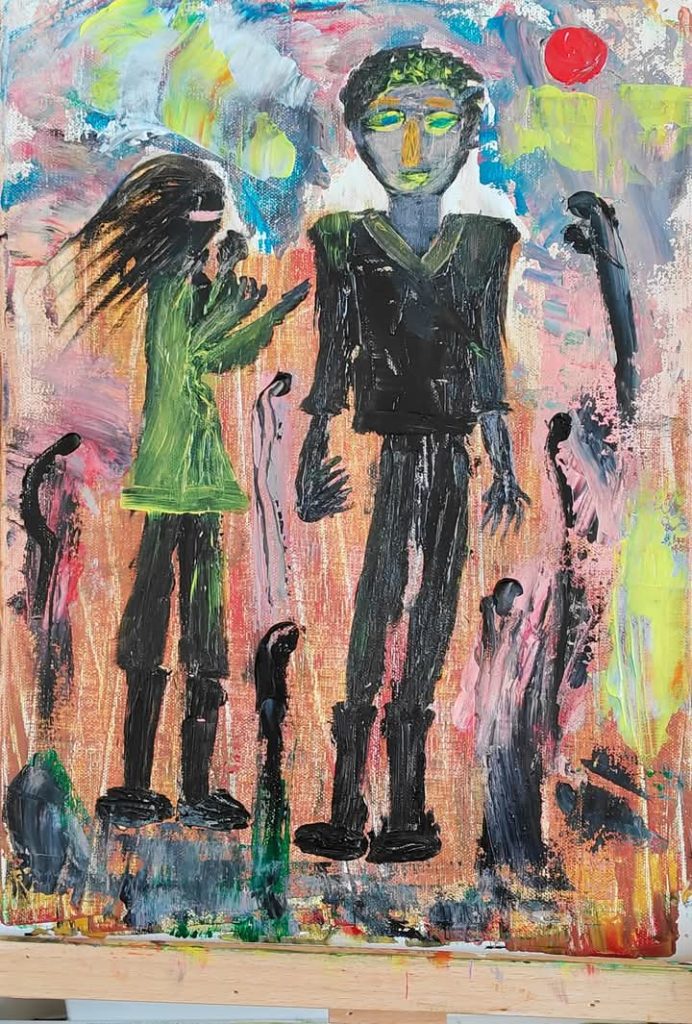The Shore: On Poets, Schiller And Making Mention Of The Goethean Observation
This is a prose poem that on the face of it in so many words is for children in conflict, war and genocide around the world from a South African poet, writing with a distinct voice for the voiceless. Writing too for the marginalised and disenfranchised, and those experiencing scarcity, lack and poverty in their lives.
“Art is the daughter of freedom,” said Friedrich Schiller, but I say that true art, writing, reading, and expressing oneself is the most noble form of the communication of the heart. Difficult to attain, tough to master but the experience, negative or positive, is thoroughly worthwhile. It is an experience that gives rise to stamina, willpower, inner strength and discipline. It was the following poets: Dennis Brutus who lived that experience, Victor Wessels who embraced it. It is poets, contemporary poets and beyond, that define that specific experience (in my books) for generations to come of what a poetic life, poetic drive, poetic force truly means. It is an experience that is based on revolutionary struggle and power, strategy, design and personal freedom.
A true poet speaks from an act, a scholarly act, a pause between words, a calm interlude, the brutal heart, vulnerabilities, and images that the pen puts to paper. Putting pen to paper is sometimes all that it takes, resting awareness against wave after wave, vibration after vibration. A true poet walks that powerful line that borders dream and reality, invention and pathway into the unknown, into uncertainty. A true poet leaps into that unknown, leaps across the boundaries and borders of heaven and cloud, and the same poet creates a vision out of nothing, out of art, out of words, out of clay hands. This artistry is unique. It belongs to the poet alone, as Dennis Brutus demonstrated in Letters To Martha, Arthur Nortje in Roots and C. Swart in I Write Riddles And Remedies.
The poet tells us that out of pathetic sadness and the frustration found in struggle, hardship and despair that beauty can still be found in our aloneness, that there is still an enduring message of hope to be found in the unforgiving nature and energy of loneliness. In a time of war, I have discovered that Chantel Swart is one of those poets. Her gift resonates through bone and sinew. As I read her poetry, I draw a long breath and on the exhale I am reminded of things I want to remember but I am also reminded of things I don’t want to remember.
She is a writer who writes for the world, for the lonely, for the disenchanted, for the disenfranchised in the same ways Nizar Qabbani, Don Afrika Beukes, Tariro Ndoro, Tendai Rinos Mwanaka, Rupert Brooke, Eugene Skeef, Mongane Serote, Khaled Juma, Refaat Alaheer, Yehuda Amichai, Nick Mulgrew, Kiran Bhat, Allan Kolski Horwitz, Miri Ben-Simhon, Diana Ferrus and Clinton V. du Plessis, Suhaiymah Manzoor-Khan have written for the interloper, for those who belong and for those who feel empty, for those who want more out of life, for those that want to be loved on their terms. These are all the poets that make Goethean observations in their work. All the writers that I mentioned write for the outsider. The poet writes for humanity. Humanity is the outsider looking in, looking for love, looking for self-acceptance.
It is the poet that is courageous. It is the poet who forgives the sins of this harsh, cruel world but it is God who forgives absolutely.
Most of all it is recognition that is wanted. The outsider wants recognition, and it is perhaps only the poet that can grant them that, isn’t that what Don Mattera defined a generation as, isn’t that what the freedom fighters who wrote poetry risked, risk? They faced assassination, and that elusive feeling of being loved for who they are, they want their identity to be embraced, they want to be identified, named, claimed, represented in the face of smoke, bone and flesh.
I remember so many things when I read poetry. When the end of a relationship came in my life, it took me years to acknowledge the pain of that ending. I discovered personal freedom and peace of mind in poetry. Childhood again, for one. That collection of sweetness and longing for mother, the presence of father and abandonment, ruin and a kind of wounded, hurt feeling. I am also reminded of a broken world, my broken world, a broken life, capturing those heady emotions and feelings in stark and bleak images. Capturing them in photographs. There they exist on the pages of C. Swart’s poetry, these images, this bleak, dull feeling inside of me as fleeting as happiness, as temporary as day and sunset. They exist for me, and for another female poet. Other poets, people of the South, other poets from Africa. I meet the sun and prayer in my loneliness in Swart’s words, on those pages.
It is important to realise that as the world falls apart around you and collapses after you have lost someone that there will always be music. Now that the relationship has ended, now that the man who was very briefly in my life is gone that is what remains. All of this beautiful and wonderful music remains. When I want to remember, when I want to think about the past, that fleeting happiness I felt so many hours and years ago I play Erik Satie, the Russian composers or Jacqueline du Pre or other classical music. John Cage, for example, or Philip Glass and what will come to me is the outline of the man’s face, the characteristic traits of his personality, the colour of the night as I watched him park his spaceship of a car in the driveway. All of these things have taken to mean so much to me. Yes, he changed me, and he is still significant.
Yes, he is still important to me. Poetry is still important to me. The crash of the music resonates throughout my entire body and a calmness is restored inside my heart. I think as I listen to the rhythm inside the piano keys of the man and I can hear him smile. I feel an ache tearing me up inside as I think of my sadness and his newfound happiness, the relationship that he has now in the country he calls home but it doesn’t matter because I have music. I have Daniel Barenboim and Leonard Bernstein and videos of ballet to watch. And as long as I have tears I will have music.
I listen to this music from the soundtrack of the film The Hours and it’s as if he’s still here. It’s as if he’s still alive for me. Your memory is still alive for me and that’s what counts. The music offers me up his memory and once more his important to me and even this is significant to me. We never really lose in love. It is just the measure of loss and grief in time. Temporary pastimes. Fleeting moments that are viewed with such precision and such mental acumen. Poets live energetic lives in flux, within a maelstrom that is never ending and that can be burdensome if they don’t get it down on paper. All I want to know as the music rises and rises and crashes against every cell in my chest and rib cage and lung and bone and meets all of this pent-up emotion within, what are the contemporary poets hailing from Africa listening to? I wonder to myself, does the man still think of me at all? I can still hear the sound of his voice in this room and sometimes that is all that matters to me. Tragic. Tragic. How tragic is that and what a bittersweet ending. Not the fairy tale after all but an ending nonetheless. I get up and make tea. The music isn’t playing anymore but it is in my heart.
Poetry belongs to the positive and the negative vibration in the wave alone. If you are a poet you speak of the truth, of what you envision, whether it is a clearer understanding of the things we hold dear in life or what we stand in solidarity with. Even the poet is innocent and can be quite innocent in their language that they use.
Even a child can understand what is right and what is wrong and the poet holds up his pen and declares like a child, like every child what is right and what is wrong. That to me is the definition of innocent. There is no struggle, no despair, no hardship in realising and acknowledging what the truth is. It is struggle, despair and hardship that is complex.
That is difficult to define and draw boundaries around. It is struggle, despair and hardship that is complicated.
When I think of Credo Mutwa, I think of the (Native American) shamans. I think of Rumi. I think of Khalil Gibran. If we do not read and write and master reading and writing how will we ever truly articulate our pain. The experience of happiness is a beautiful experience and it can be profound but pain, emotional pain, the “dense pain body” that Eckhart Tolle spoke of in The Power Of Now can be profound too and both happiness and pain can transform our being. This change can be inspiring, a motivating factor in our lives. To these people, to the poets that came before and after, money, wealth and prosperity meant nothing to them, as did material possessions. To our intellectuals, our philosophers, our teachers it is what leads to the betterment of society that is significant to them, what are the aspects of humanity that are noble and virtuous. The greatest of these are the poets, poetry.
It is far easier to carry pain in one’s heart than happiness. It is far easier to acknowledge a clinical depression than to laugh. But in the face of both suffering and malevolence in the world, in the face of sadness, utter despair and struggle, in the face of solitude, silence and the endless hours stretching out before you, there is poetry. There will always be poetry that will save you.
To taste the sweetness of life, to experience the hardship and overwhelming grief of loss and the emptiness of the world without your loved one at your side. For melancholy to always be in your inner circle, for clinical depression to never leave you, for flowers and the smell of incense burning to be a constant presence in your life, on your desk, beside your papers and important books is for your soul to be absolutely ruled by and run by and nurtured by and nourished by poetry. Who is a poet? What is a poet? If life exists, if you are alive, then you are a poet.
In love you will always find despair, always, but in poetry, for poetry to exist, it means love must exist. It means that suffering and death must co-exist. The hours may be empty but you will always have shapes of consolation. Even the intellect can and will offer you hope and cause for reflection for nothing is lost in life. The sea has waves and even the river can nourish your soul. Look, from the river to the sea, the poet finds whatever nourishes their soul. The blue sky, the green grass. You choose. It is always your choice. To despair or find the silver lining, find life, find love.
Published on the Modern Diplomacy website in the African Renaissance blog on November 14, 2024 and published again on the Ovi website on November 23, 2024.







